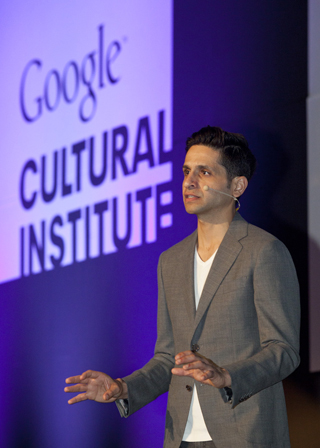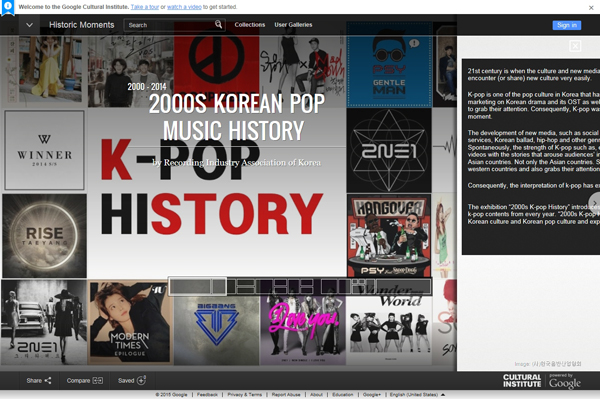Google features more content from Korea on cultural platform

Amit Sood, director of the Google Cultural Institute, explains Google’s new partnerships with Korean cultural institutions at the MMCA’s Seoul branch. Provided by Google
Amit Sood, director of the Google Cultural Institute, said during his visit to Seoul yesterday that the U.S. company has entered into partnerships with 10 additional Korean cultural institutions, including the National Museum of Modern and Contemporary Art (MMCA), the Academy of Korean Studies and the Recording Industry Association of Korea.
Besides these, Google formed partnerships with 10 other Korean institutions, including the National Museum of Korea, since it launched its Google Art Project in 2011, wowing art lovers internationally with virtual tours of major museums around the world and high-resolution images of the masterpieces they house. The Art Project has been extended to the Cultural Institute to embrace not only visual art but also intangible culture and related archives.
Now, Google has more than 700 partners from 60 countries providing images of more than six million cultural objects. Among them are 13,500 photographs of Korean objects such as the 1,500 high-resolution images added through the new partnerships.

An unknown Joseon painter’s “A Portrait of Yi Chungwon” (1604) is one of the six Korean cultural pieces now represented in ultra-high-resolution gigapixel images on Google Cultural Institute. When zoomed in on, the images show even the details of brush strokes invisible to the naked eye.[Screen capture]

An unknown Joseon painter’s “A Portrait of Yi Chungwon” (1604) is one of the six Korean cultural pieces now represented in ultra-high-resolution gigapixel images on Google Cultural Institute. When zoomed in on, the images show even the details of brush strokes invisible to the naked eye.[Screen capture]

An unknown Joseon painter’s “A Portrait of Yi Chungwon” (1604) is one of the six Korean cultural pieces now represented in ultra-high-resolution gigapixel images on Google Cultural Institute. When zoomed in on, the images show even the details of brush strokes invisible to the naked eye.[Screen capture]

“K-Pop History” is part of the 33 new digital exhibitions about Korean culture on the Google Cultural Institute. [Screen capture]
“I don’t care where the content is. What is important is that the museums started opening up their amazing collections due to this project and they are now accessible,” he said. “If the information I was looking for had been available four years ago, I would not have started this project.”
Sood pointed out that when we search with a keyword - love, for example - the results ranking high are not very cultural. Through the Google Cultural Institute’s digital gallery featuring old and modern masters’ art on love, the number of views of these images increased, improving the possibility for the content to be shown higher on search results, he said.
“The IT service wants the Internet [to be] more cultural by leading more views on those contents,” Sood said.
So is Google converting from a neutral portal to a cultural editor?
“Not at all,” he said. “We don’t choose the artworks - the content. As for Korean partners, they select the works that they think are best to represent Korea.”
He also emphasized that Google provides a platform on which its partners can develop their own mobile applications themselves.
Find Google’s cultural project on www.google.com/culturalinstitute.
BY MOON SO-YOUNG [symoon@joongang.co.kr]










with the Korea JoongAng Daily
To write comments, please log in to one of the accounts.
Standards Board Policy (0/250자)